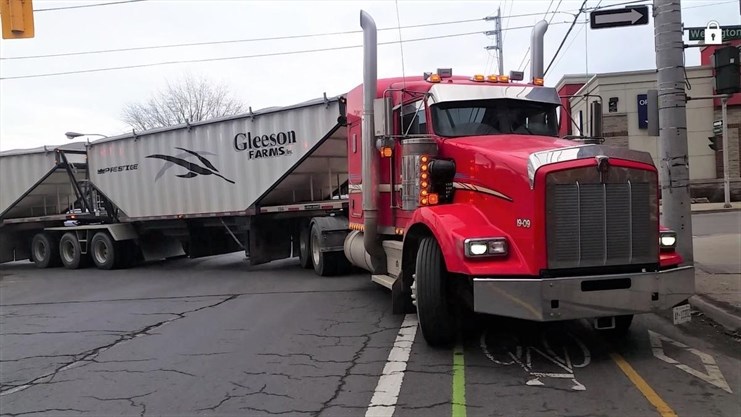The city is reviewing its designated truck routes for the first time in a decade and a growing number of residents want big rigs off their streets.

Sean Burak
An eighteen-wheeler turning wide onto Cannon Street last Friday forced a cyclist to backpedal out of harm’s way — even though he was standing with his bike in a “protected” two-way cycle track.
An eighteen-wheeler turning wide onto Cannon Street last Friday forced the veteran cyclist to backpedal out of harm’s way — even though he was standing with his bike in a “protected” two-way cycle track.
Big trucks veering from Wellington Street into the Cannon bikes lanes is “a daily occurrence,” said Burak, a downtown bike shop owner who routinely uses the supposedly-separated-from-traffic path to ride to work.
“If there is no one in the (bike) lane, it doesn’t look so bad. But imagine if you’re a cyclist riding up to that intersection when one of those big trucks makes that turn … It is pretty terrifying.”
Burak recorded the encounter to add to a collection of visual evidence he is highlighting ahead of the city’s first review of designated truck routes in a decade. A committee meets Tuesday at 1 p.m. at Hamilton City Hall to consider marching orders for a consulting study of the route master plan. (The public can attend.)
Local residents, cycling advocates and environmentalists all plan to be there with a common goal: to convince the city to stop transport trucks from “shortcutting” through residential areas to the highway.
That’s actually a tricky request if you’re a big-rig driver looking for the fastest route from the industrial port lands to Hwy. 403 in the west end.
While Niagara-bound trucks can simply zip eastward down industrial Burlington Street to the QEW, to the west the same street peters out in a residential area. That means heavy trucks rely on designated streets like Queen, King, Main, Cannon and Wellington to reach Hwy. 403.
But people live, cycle and work along those streets, too, said Beatrice Ekoko of Environment Hamilton.
Volunteers have conducted big-rig counts on some of those truck routes — including on Wellington, which sees 18-wheelers rumble by the hospital every 1.5 minutes at the busiest times. Other residents report a large truck every three minutes at morning rush hour on Cannon near Catharine Street.
University of Toronto studies suggest industrial trucks are some of the “biggest culprits” when it comes to poor neighbourhood air quality, Ekoko said. That’s why Environment Hamilton wants the review to factor in air quality when creating a “more sophisticated, less permissive” master truck route.
A city report acknowledges the truck route review faces “often competing goals” of creating livable communities while promoting economic growth.
Project manager Steve Molloy said he expects the review to take a deeper dive into collisions statistics along truck routes, noting the city has committed to a “Vision Zero” strategy to cut street deaths. It will also seek feedback from the trucking industry and its customers on the impact of any route changes.
For example, forcing all Toronto or Brantford-bound truck traffic from the bayfront to backtrack east along Burlington Street to the Skyway — a suggestion of some residents — could drive up fuel costs and kilometres travelled for truckers or affect just-in-time delivery, for example.
The Hamilton Port Authority recognizes from its own “community conversations” that the review is important to residents around the industrial bayfront, said spokesperson Larissa Fenn. She said a “robust consultation” is needed with a study of alternatives like route changes, new signage and street design.
Ahead of the review, neighbourhood residents are already sharing photos and frustrations under the social media banner Truck Route Reboot Hamilton (@TruckRebootHam).
The grassroots effort is “not about banning trucks,” emphasized Burak. “We know trucks have to use our roads to do local pickups and deliveries. No one is saying that should stop,” he said.
“But if your industrial-sized transport truck is heading from the ship to the highway, it doesn’t have to go through someone’s residential neighbourhood along the way.”
Source: The Hamilton Spectator
